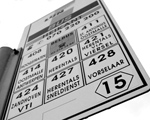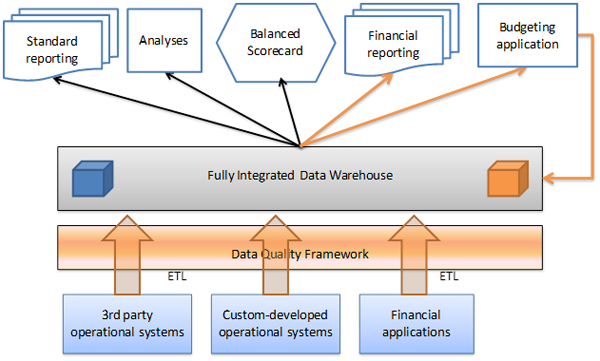
This case study will describe the challenges the Flanders public transport provider, VVM De Lijn, has been able to overcome by adopting a company-wide Performance Management program. This multi-year program is currently in its execution phase and significant results have already been booked.
The customer
"De Vlaamse Vervoersmaatschappij (VVM) De Lijn" is responsible for the preparation, planning and execution of all public transport in Flanders by bus or tram. It employs approximately 8.000 employees and is organized in five operational entities and one central headquarter. Each local entity is relatively autonomous in the sense that it has its own operating budget, managed according to policy restrictions and in line with the strategic planning cycle. De Lijn's total annual budget exceeds 1.000 million, of which employee costs and bus operations subcontracting are the biggest components.
Because VVM De Lijn executes social public transport programs on behalf of the government, it is considerably subsidized. This implies the need to have transparent governance and reporting processes and systems. On the other hand, European de-regulation requires them to show that they are not over-subsidized because they operate in a sector that is becoming more competitive.
The challenges
The main driver for adopting a corporate-wide Performance Management program & solution was the requirement to considerably improve management insight into the operations of the company, enabling them to realize the corporate strategy in a more effective way. In fact, De Lijn's strategic direction is fixed in a 5-year management contract ("beheersovereenkomst") with government. De Lijn management decides autonomously how the available means are then applied in the most efficient way in order to meet the goals set out in this management contract.
De Lijn also wanted to address the following challenges with this program:
- Improve operational and financial performance by consolidating data from the five entities and by addressing substantial data quality issues caused by operational source systems (mainly AS400 based)
- Be able to better comply to regulatory reporting needs and to respond more quickly to ad-hoc (government) questions
- Improve the internal efficiency of the personnel deployed in producing reporting & analysis (Business Intelligence) and reduce operational costs
- Improve consistency of reporting (single version of the truth + common business metadata)
Finally, VVM De Lijn also wants to be ready for upcoming challenges. The Enterprise data warehouse has been identified as the core component for all future reporting and therefore will be part of all the future corporate initiatives such as the ongoing RETIBO project (Electronic ticketing on every vehicle), so the design platform will need to support and deliver large amounts of data to various business domains.
The solution
De Lijn has always been an early adopter in the field of Business Intelligence and Data Warehousing, with first initiatives been taken as early as in 1998. The current Performance Management program, initiated by De Lijn's finance department together with element61, is groundbreaking because the solution is the result of a combination of many different projects with huge technical, functional and organizational challenges and inter-dependencies.
The core of the solution is a Business Intelligence & Performance Management architecture that supports all main decision-taking and planning processes and data flows. Central to this architecture is the Enterprise Data Warehouse that holds a uniform and consistent view on all the relevant corporate data. This data warehouse feeds all Reporting, Analysis and Scorecarding applications, and can be considered the single source for correct historical data. Furthermore, it is completely integrated with the Planning and Budgeting solution as it provides actual data to it and gets back planned and forecasted data, it is therefore also the source for all forward-looking business analysis.
Conceptual Architecture

All of the data that enters the data warehouse, is subject to thorough data quality controls and processes in the data integration layer. This ensures that the information, available for decision takers, is as complete and as accurate as possible. This flexible Data Quality (DQ)- framework is built on the best practices and recommendations on data quality by Ralph Kimball. This enables the application of business-oriented data quality rules prior to moving the data into the data warehouse, as well as extensive reporting on data quality issues that will serve to improve all operational systems.
Technical Architecture
From a technical point-of-view, the solution has a strong IBM footprint. It consists of the following components:
- IBM DB2 database on Iseries
- IBM Information Server/DataStage 8.1 for ETL and Data Quality processing
- IBM Cognos BI 8.4 for reporting, analysis and scorecarding
- IBM Cognos TM1 9.2 for analysis, planning and budgeting
The solution in detail
This conceptual architecture has implied the building of three major blocs in the VVM De Lijn Landscape:
- A new Enterprise Data warehouse to collect and store the data needed
- the development of a unique and central Business Intelligence platform
- and finally the creation of a planning and budgeting application.
Those 3 blocs have been created in parallel and are strongly dependent of each other in order to offer a complete and integrated Business Intelligence and Performance Management solution.
Enterprise Data warehouse
The De Lijns Enterprise Data warehouse (EDW) consolidates the data from five different entities enriched with corporate data at the lowest level possible in order to offer the most accurate, flexible and complete reporting possibilities.
It consolidates data on the following domains:
- Finance: Budget and actual financial transactions
- Personnel: Personnel data and the actual and planned costs attached to them, which represent most of De Lijn costs
- Kilometers: Planned and Actual Kilometers and hours driven by De Lijns vehicles, which obviously represent De Lijns core business
- Worked Hours: Planned and actual worked hours of De Lijns employees
- Vehicle GPS positioning: Exact Timestamp when a vehicle stopped at a stop in order to measure De Lijns network performance and services delivered
All those data domains are connected together using common dimensions which allow to manipulate and to mix them in a very easy and effective way. The EDW can then calculate and deliver complex KPIs such as the cost per kilometer driven, bus line performance and many more which are using a combination of 3 or 4 of those domains.
Of course not all those domains have been loaded at once; it has been done over time, following a phased and iterative approach. Constant focus was given on the right mix between immediate usage of the data and keeping in mind future usage in order to avoid any major redesign at a later phase, when more and new subject areas where introduced in the EDW.
During the design phase, but also on an on-going basis, a specific focus is on controlling and monitoring the data quality of the data stored using a fully automated framework based on Ralph Kimballs approach. This solution allows to measure the quality level of the data at a certain moment of time but also to do trend analysis over time to be able to detect any recursive or increasing data quality issue. This is a mandatory step in order to be able to deliver and guarantee a sufficient level of quality of management information delivered to the business users.
The De Lijn's EDW is refreshed daily overnight thanks to a fully incremental process between the source systems and the EDW but also within the EDW; this set-up is delivering up-to-date data to the users every morning.
Business Intelligence
Using the IBM Cognos BI suite, a wide range of Business Intelligence applications are now offered to the user community. Actual users of the solutions can be found at all levels of the organization but also in all its dispersed geographical locations.
- Standard reporting: The standard reporting environment consists of 100s of Cognos BI reports that serve hundreds of end-users; they range from very basic list reports to complex dashboard-like interactive reports.
- Analytical reporting: Using IBM Cognos TM1 functionality a range of analytical cubes have been developed in order to offer a flexible and dynamic solution to analyze data such as budget versus actual drivers. These cubes allow the business analyst to faster answer to any internal or external ad-hoc questions.
- Scorecarding: A large set of scorecards have been developed during two main projects. The first one had as objective to develop a balanced scorecard of the main KPIs in order to support management board decisions. The second one had the objective to deliver a scorecard to measure and track customers satisfaction based on the data produced by the on-going survey run by De Lijn. These two projects have been delivered and are now in an operational phase for 1,5 year.
The unique source of all these BI solutions is the De Lijn's Enterprise Data Warehouse that ensures they are all sharing and using the same data set. De Lijn now has a unique and stable platform to develop and execute reporting based on a single source which has improved the quality and consistency of the analysis produced, reduced the time to answer to new analysis request and finally significantly extended the capabilities and complexity of the analysis produced.
Planning & Budgeting
With the planning solution TM1 version 9.5.2, a company wide Corporate Performance Management (CPM) - solution has been created to support the yearly budget process and give the ability to do a monthly forecast if necessary. The main focus on the cost side of the Profit and Loss statement is Personnel cost. As this cost represents about 45% of the total cost of De Lijn, in order to facilitate a correct budget for this component, a detailed calculation based on cost drivers has been built. This allows management to set drivers and parameters as central planning assumptions so all budget owners use the same cost drivers, like eg. index % and meal voucher amount, and results in a fully automated calculation process consolidated into the P&L statement.
The calculation of the personnel cost is split into a section for the white collar workers and a section for blue collar workers. The white collar calculation is pretty straightforward and is mainly built around the salary component and the FTE percentage. For the blue collar workers, a more complicated calculation is added and this uses the link between the personnel budget and the planned journeys of the buses, trams and other vehicles. This is done in order to know exactly what the extra personnel cost is for work on Saturdays, Sundays and holidays and allows De Lijn to see if the planned staff is available to drive all the planned journeys or whether extra personnel is needed or if the current personnel will need to do extra time.
Not only the personnel cost is implemented in the planning application, the entire profit and loss statement can be filled in by the different departmental managers for their specific department in order to come to a result per department, entity and De Lijn as a whole.
The base information for all personnel data and the planned journeys comes from the data warehouse and can be adjusted were necessary. The final result is fed back to the data warehouse so a detailed analysis and reporting on actuals versus budget or forecast can be done in every department.
Change management
Putting in place this complex technical architecture was accompanied by a change management program that was aimed at stimulating the optimal use of technology by decision takers at all levels in the organization. Key components of this were:
- The introduction of a Business Intelligence/Performance Management Competence Center, that is the owner of the architecture and that guards the coherence of the data warehouse. This team is also responsible for the relationship with the ICT department and all business users of the architecture.
- Communication campaign about all realizations and plans of the program.
- New process, roles and methodology for dealing with all business/project requests from the rest of the organization. This occurs in line with the corporate Project Portfolio Management best practices.
- Empowering key business users and enabling them to create their own analyses and reports through an extensive training program. This improves their autonomy and responsiveness, while the centrally managed architecture still guarantees consistency.
The combination of a best-of-breed technical architecture and a gradual and tightly managed change management process have resulted in an increasing adoption and success of Business Intelligence and Performance Management at De Lijn.
The results
While the Performance Management program is currently still in progress, incremental projects from the roadmap already deliver tangible benefits :
- Efficiency improvements for the department that is responsible for maintaining the BI and Planning systems. The team (10 FTE) spends less time on system maintenance and looking for required data & information, and can spend time in assisting the business in the actual analysis of data. It is estimated that across this team, 30% of all capacity is freed up for more added-value activities instead of manual data integration work and spreadsheet cut & paste activities.
- The Budgeting process (with 40-50 budget owners) is now following a driver-based approach and happens much more effectively and quickly and is much less error-prone. Budget owners spend less time entering numbers & transmitting them; the controlling department has saved FTE per year in reduction of manual budget consolidation work.
- The Planning and Budgeting application now offers the possibility to create several forecasts a year in an effective and secured way.
- The Data Quality architecture has uncovered previously unknown data quality issues with some of the key corporate data elements (like personnel and vehicles). This has led to concrete initiatives to correct and improve data quality company-wide, which leads to both more accurate and reliable operational processes and Business Intelligence information.
- The original investments to set-up this architecture are now paying back as the developed Enterprise Data Warehouse can be extended easily and effectively to face De Lijn new challenges.
- A tighter integration between Strategic Planning, Project Portfolio Management, Budgeting and Financial Reporting, all linked through the Performance Management architecture, will enable De Lijn Senior Management to have better information to run the company. For example, senior management is increasingly using the automated Balanced Scorecard to monitor De Lijn's performance against its strategic goals.
- Last but not least, the project has led to a surge of usage of Business Intelligence in the entire organization; a significant shift of corporate culture has been achieved for hundreds of end-users going from senior to operational management level: these users are gradually moving towards a more fact/number-based modus of decision taking. Where people often used to rely on experience or "past practices to run their part of the business, they are now increasingly using Business Intelligence to drive their decisions.
Role of element61
De Lijn considers element61 as its strategic partner in the conception, design and implementation of all technical and process components of this Performance Management & Business Intelligence program. The main activities for which De Lijn relied on element61s expertise include the following:
- Program management of the overall program, as well as Project management for some of the key projects
- Complete design of the architecture & infrastructure
- Advice on selection of software components and their best practice implementation & integration
- Introduction of best practices in Project Management and Business Intelligence methodologies
- Technical expertise on each of the software modules for both complex implementation and knowledge transfer in a co-development and coaching model
- Advice on change management of introducing a Performance Management program in a complex organisation such as De Lijn.
De Lijn and element61 have successfully concluded the first projects in this complex program and are committed to delivering long-term added value by realizing the vision of enterprise-wide Performance Management in this public sector environment.
